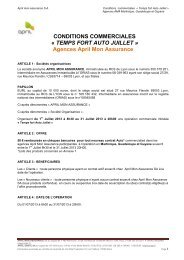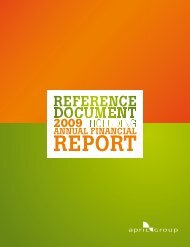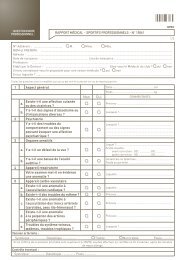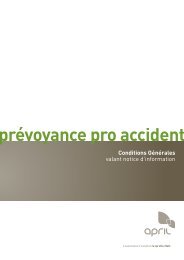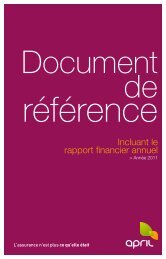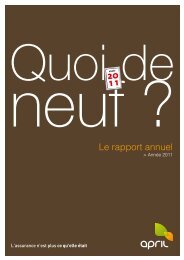2007 - April
2007 - April
2007 - April
You also want an ePaper? Increase the reach of your titles
YUMPU automatically turns print PDFs into web optimized ePapers that Google loves.
3.0<br />
Information on the company’s activities<br />
Haussmann Conseils<br />
APRIL GROUP completed the acquisition of 80% of<br />
Haussmann Conseils on October 1 st , 2003. This company<br />
designs group programs for personal health and personal<br />
protection insurance.<br />
COUCHON Assurances<br />
APRIL GROUP acquired 100% of COUCHON Assurances on<br />
December 23 rd , 2003. This company specializes in the design<br />
and management of P&C insurance policies for individuals.<br />
FORUM FINANCES<br />
APRIL GROUP acquired 100% of FORUM FINANCE on<br />
October 1 st , 2003. Until this point, the Group had owned a<br />
59.58% interest in FORUM FINANCES.<br />
3.4.2. Investments underway<br />
The Company is constantly looking into opportunities for<br />
investments.<br />
3.4.3. Future investments<br />
The Company is constantly looking into opportunities for<br />
investments.<br />
3.5. Management report<br />
See the Executive Board’s management report on page 50<br />
and following<br />
3.6. Issuer risk: risk management at APRIL<br />
GROUP<br />
3.6.1. Identification of risk factors<br />
The Risk Manager is responsible for the overall management<br />
of risks within the Group. Within this framework, the risk<br />
manager has been tasked to identify the main risk factors<br />
defined in the APRIL GROUP risk repository: financial risks,<br />
risks relating to businesses and insurance operations,<br />
operational risks, accounting risks, strategic risks and legal<br />
non-compliance risks.<br />
He is also responsible for identifying new risks based on the<br />
information available or exchanges with risk or insurance<br />
professionals, and members of the Sustainable Development<br />
Committee.<br />
Lastly, he works with the findings and recommendations set<br />
out by the internal audit manager in connection with their<br />
audit assignments and the assignments carried out by other<br />
players, including financial controllers, business division<br />
auditors, Statutory Auditors, etc.<br />
The risk manager informs and advises the Group Committee,<br />
and reports on this mission to the Sustainable Development<br />
Committee.<br />
Each type of risk is subject to an in-depth review, with a risk<br />
map and action plan drawn up for each company, aimed at<br />
eliminating, transferring or reducing the residual risk. The<br />
company’s managers are responsible for implementing the<br />
action plan defined in connection with the audits or mapping<br />
processes, formally reporting at least once a year during<br />
June’s Strategic Committee meeting<br />
At the same time, the Group internal audit manager ensures<br />
the coherency and efficiency of internal control within Group<br />
companies. He coordinates and controls the activities of all<br />
the Group’s internal audit players.<br />
An annual audit plan is drawn up, factoring in exposure to<br />
risks in the various Group companies. This plan concerns all<br />
the companies in the Group.<br />
The plan for Year N is validated at the end of Year N-1 by<br />
the Group Committee. It is formally reviewed and presented<br />
to the Sustainable Development Committee twice a year for<br />
follow-up. It may also be updated as and when necessary<br />
according to the priorities identified over the course of the<br />
year. Several types of mission are carried out: cross-business<br />
and optimization missions, specific audit and control missions,<br />
follow-up missions for companies recently incorporated into<br />
the Group, and follow-up missions on previous audits. These<br />
missions are performed based on a set of standards that all<br />
Group company managers are familiar with: the internal audit<br />
charter.<br />
A written report is drafted along with a synopsis of the<br />
recommendations issued further to all such missions.<br />
Recommendations are classified into 3 categories: high risk,<br />
moderate risk, low risk. For each recommendation, a deadline<br />
is set and a manager appointed.<br />
The application of recommendations is monitored through<br />
follow-up missions during which progress made against the<br />
planned deadlines and recommendations is checked.<br />
25<br />
Return to the contents section




